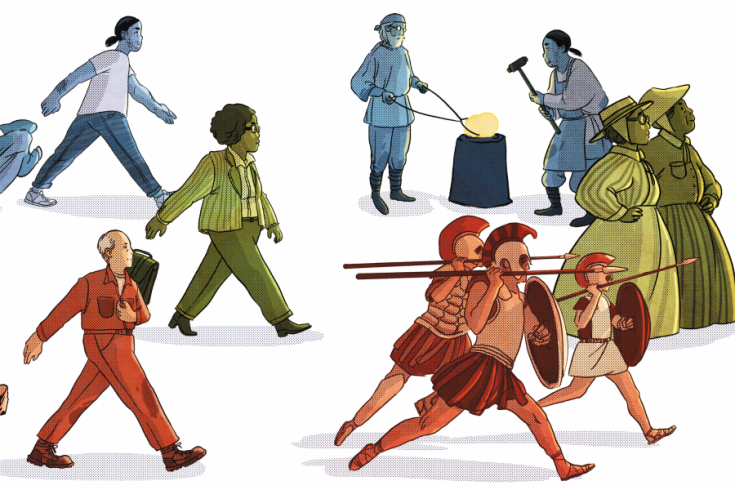It’s a drizzly day in Marathon, Greece, and a group of citizen-soldiers in bronze breastplates and tunics are lined up one behind the other. Each man pushes on the back of the man in front of him; the man at the front of the column pushes against a 3,000-year-old pine tree. It’s a strange sight on its own, made stranger by the pressure gauge attached to the tree—and the fact that this is happening in September 2015.
Listen to an audio version of this story
For more Walrus audio, subscribe to AMI-audio podcasts on iTunes.
The soldiers are dressed for a re-enactment of the ancient Battle of Marathon, which took place about 2,500 years ago; the pressure gauge is for testing a modern theory about military tactics. A group of living-history enthusiasts—people who dress up in period clothing and practise historical crafting or martial arts—planned the trip and brought along a scientist with a hobby interest in the way the ancient Greeks waged war.
Historians have long debated whether arranging soldiers in this way would add to their collective strength—perhaps after ten people, more wouldn’t make a difference? “Oops, false,” says Christian Cameron, a seasoned re-enactor and one of the event’s organizers. “In fact, as far back as we could successfully stack people, they could continue to [add] meaningful amounts of force.” Some suggestion of this appears in historical sources, Cameron says, because evidence shows that people freed their slaves before a big battle. “When I’m a small farmer and all I own is you, and I free you, I have made a 100 percent capital investment in this battle,” he says. “So we had evidence that this mattered, but it was fascinating to prove it right.”
Cameron and his companions are captivated by what’s generally known as historical re-enactment: roughly, dressing up and messing around with historical items. It’s hard to estimate the size of the re-enacting community; people may join a battle once, or only for special events, or they may be dedicated weekend warriors (literally) but only within a private group. Skirmish, a monthly living-history magazine, estimates its readership at 50,000 “hardcore re-enactors, living historians, and history enthusiasts” from around the world. And though it’s hard to pin down the precise origin of re-enacting, we do know that re-enactments of Civil War battles started even before the war itself had ended. Soldiers and veterans would participate in “sham battles” to demonstrate to those back home what being in the war looked like, for their education and amusement. The Society for Creative Anachronism, maligned by serious re-enactors (who roll their eyes at the society’s focus on fun over fact), held its first tournament in 1966. According to its website, the society now hosts more than 1,000 events worldwide every year.
Playing with swords and satisfying historical curiosity are certainly big draws. But re-enactors also keep coming back, despite the wet wool and lack of pants, because of the communities they form, often with people they wouldn’t otherwise meet. It’s a way to share a campfire meal with friends and try out martial arts, yes, but these re-enactors are also chasing an elusive feeling—that moment of forgetting where and when they are, of stepping outside of themselves.
It isn’t only recreational. Craftspeople specialize in creating historical replicas, like the armour that was used in the Marathon re-enactment. Experimental archaeologists test specific hypotheses about aspects of history as a form of academic inquiry. Inevitably, some guesswork is involved; recreating the past means you have to fill in a lot of little gaps in the historical record. Re-enactors rely on written sources and archaeological research, and they sometimes uncover new details as they try things out. Some discoveries are accidental, like realizing that if a shield is impossible to carry around all day, it is probably too heavy, so the documents its design is based on were likely misinterpreted. Other discoveries are the result of careful testing, such as a recent study published in Environmental Health that had researchers recreate traditional bitumen-coated water bottles used by the Indigenous peoples of California’s Channel Islands to measure exposure to certain toxic compounds.
Debates about history—about whose history gets recorded and who feels they can play with history—are becoming increasingly contentious. Some American cities are now reviewing the role of their Confederate monuments, for instance, and in the process have spurred a public re-examination of the Civil War. Re-enactments are another arena in which canonical history is now being challenged.
Christian cameron, now a fifty-five-year-old historical fiction author and US Navy veteran, first became interested in living history when he was thirteen and taking part in a battle re-enactment for the 200th anniversary of American independence with his Boy Scout troop in western New York. His father, a professor of theatre history, started pushing him to think more deeply about what he was doing. “Dad asked these really hard questions, like ‘Do we want it to look like or be like?’ And it turns out that’s a very fundamental question to the world of experimental archaeology,” Cameron says. “I’d be having a great time in a fake battle and my dad would say, ‘What are we doing right now? Why? Is this how battles really were?’”
This tension between “looking like” and “being like” exists throughout the world of re-enactment. Is it about dressing up for fun? Is it about trying to learn how people from the past would have lived and felt? If everything isn’t exactly right, is there a point to doing it at all?
Even within specific groups of re-enactors, people hold a range of views about how closely clothing, items, and activities should mimic the originals. “Some people are button and stitch counters, and they’re not much fun,” says one re-enactor, dressed in wool clothes and standing in a field outside Hamilton, Ontario. (He was taking part in an annual living-history recreation of late medieval Italy, in the spring of 2016.) “They’re so historically correct it becomes ridiculous.”
Cameron wears his hair in a short ponytail (long hair is conveniently adaptable for a number of historical periods), talks in complete paragraphs, and seems just as comfortable in a hip, downtown coffee shop as he does wielding a sword. He says he wonders sometimes if many re-enactors’ obsession with objects and outfits is just “crass, modern materialism” imposed on history. “There seems to be an awful lot of ‘I’ve got a nicer one than yours,’” he says—especially with elaborately wrought costumes. But discoveries have also been made precisely because re-enactors were living history as accurately as they could.
Cameron recalls one night when he and his friends, including a professor who specialized in eighteenth-century American archaeology, were in the Adirondack Mountains, dressed as Loyalists and British Army troops. The clay pipes they’d been smoking were filthy with days’ worth of tobacco buildup, so they put the pipes in the fire to burn clean, as was done in the 1700s. One camper got up in the night and tossed a log on the fire, accidentally breaking all the pipes. The next morning, Cameron says, “Doug, our archaeologist, leaped with joy because all over North America he had found fire pits full of broken clay pipes.” Apparently, the going theory had been that as the soldiers packed up camp, they would put all the pieces of the pipes that had broken into the fire pit. “Doug, who had been a US soldier, said, ‘That made no sense to me. Soldiers are sloppy. They don’t pick up anything.’” Cameron continues: “It wasn’t an important question—it’s not going to change anyone’s view of early American archaeology or early American economy. But it was a question and it was absolutely answered, and the validity took about a million levels of authenticity.”
It can be hard to convince academic historians that you have learned something they didn’t know just by trying it out in the real world. The practice of experimental archaeology is more accepted in Europe, where some universities grant degrees in the discipline. But even in North America, academics and re-enactors have collaborated in a few cases.
Cameron “is the only student I’ve ever taught that owns a full suit of Milanese plate armour made to fit him,” says Richard Kaeuper with a laugh. A medieval historian at the University of Rochester, and a former professor, now friend, of Cameron, Kaeuper has found his own work helped along by insights gleaned from re-enactment. Kaeuper, in one of his books, had explored the theory that knights may have worn plate armour as part of their penance; Cameron, who had been wearing this kind of armour for progressively longer periods and finding it uncomfortable, was able to verify that this was indeed plausible.
Most historical inquiry is not formed so much by experience, but Kaeuper says he has even learned how knights may have felt while jousting from a man doing a demonstration at a Renaissance fair. They chatted about how much it hurt to fall off a horse and about how, like the famous knight William the Marshal, you do sometimes have to get a blacksmith to carefully pound your helmet back into shape while it’s still on your head so you can then take it off.
Darrell Markewitz, a professional blacksmith who works north of Toronto, has been trying for more than a decade to smelt iron the way Vikings did. The historical record shows that the Vikings had iron—swords and other artifacts around the world prove it—but we don’t know precisely how they made it. One hot Sunday nearly two years ago, about ten people gathered at Markewitz’s property in Wareham, Ontario. Helpers smashed charcoal blocks into small pieces to feed the fire, which had to burn consistently—a delicate balance that Markewitz had attempted, he estimates, more than eighty times. The burning carbon in the smelt pulls the oxygen out of the iron ore, purifying the metal. Of course, this is what we now understand to be happening. In the early Middle Ages, nobody would have understood this chemistry, and blacksmiths relied on teachings passed down through generations. Markewitz—who has presented academic papers on his research to conferences at the Royal Ontario Museum and at Wilfrid Laurier University—rounded out our theoretical knowledge with these practical details, learning how much coal and iron are needed, how long they need to burn (the smelt that day took about six hours), and even how to tell whether the process is going well based on the sounds the fire makes.
These may seem like small details, but for participants, re-enactment provides an important window—an opportuniy to understand the past as it may have been experienced by the people who lived it.
Kaeuper, the academic historian, has reservations about the broader accuracy and ethics of re-enactment and says he’s “worried about the dangers of powderpuffing the past and making it look less dangerous than it was,” especially because it often celebrates and encourages participation in battles. “It looks colourful and sort of harmless, and people may shout, ‘Ah!’ and fall down clutching their breast, but they’re not going to bleed,” Kaeuper says. “There’s always that danger of romanticizing the past that I am sensitive to.” He notes that “we don’t see re-enactors burning or raping—thank goodness they aren’t.” But, he continues, “there’s an essential falseness” to the idea that history was all fun and that war used to be romantic, cool, celebrated. “We can’t forget to shudder—battles are not play.”
If one major risk of re-enactment is that it romanticizes the past, another is that it is wildly selective: not everyone has a history that would be fun to relive, and few people are interested in playing a slave on the weekend. Inevitably, most history does not get re-enacted. Though most re-enactors are not explicitly motivated by the selectivity, some do enjoy it for nationalistic reasons. It lets them play in an imagined past, free from their pet complaints about the modern world.
Civil War events are among the most popular to re-enact, attracting all sorts of people. And some of those people really want to be Confederate soldiers. Many become interested in participating through a personal or family connection—so if you live in the South, you may have had an ancestor who fought on the Confederate side of the war. And some are then inspired to follow in their ancestor’s footsteps, perhaps too closely. For these re-enactors, it’s not just a fun hobby, it’s tied to something much deeper to their identity—and, in particular, to improving the image of their ancestors by portraying them as honourable and brave.
Kimberly Miller-Spillman is a textiles professor at the University of Kentucky who studies re-enactment costume. In her research, she has come across a number of Civil War re-enactors who are unwilling or unable to switch sides at a re-enactment. Re-enactors will often have both Union and Confederate uniforms, although neither is cheap to assemble, and will go on whichever side needs men. But some, typically men who have a strong political or family connection to one side, simply won’t. At Civil War events, the scale is usually tipped toward the Confederate side, although during the actual war, the Union Army outnumbered the Confederates.
Unsurprisingly, there aren’t many black Civil War re-enactors, and they are almost always on the Union side. Patricia Davis is a professor of communication at Georgia State University who has written about these re-enactors, and she says that many black people aren’t interested in re-enacting because they see the Civil War as a history that belongs to white southerners, or they might be discouraged because they assume that many white participants want to be in an environment where they can be freely racist. The ones who do participate, she has found, often do so because they are trying to educate people. (Similarly, in Canada, most Indigenous re-enactment takes place in an educational context.) “For African American re-enactors in particular, the causes and the consequences of the war are important for them to get across to the visitors at re-enactments, and what they often do in these interactions is they talk about how the history of slavery [and] the history of reconstruction have everything to do with racial inequities in the present,” Davis says. “And then a lot of them emphasize to me as well, visually seeing black men and women working in various ways to secure their own freedoms—they’re letting people know, ‘Look, we didn’t just sit around and wait for Abraham Lincoln and white Union soldiers to free us, we were actively engaged in securing our own emancipation.’ That has a huge impact on black children in terms of their ability to see themselves as important and valuable people.”
As historical re-enactment continues to evolve, these questions about what exactly it is—and who it is for—are also intensifying. Some Civil War groups are so wedded to a certain kind of precision that they are concerned about accepting participants over a specific weight, arguing that soldiers were thinner back then; others are committed to material accuracy but accept some anachronisms to accommodate diverse enthusiasts.
Back in Hamilton, at the re-enactment of medieval Italy, the night gets chilly and everyone moves closer to the fire. The woman who usually cooks for these events—renowned for both the precision of her culinary research and the tastiness of her meals—pulls out a Ziploc bag of stew. She pours it into the period-accurate metal cauldron over the flame and then pulls out a smaller bag: one of the re-enactors is on a nut-free diet, so she’s made a special meal for them. Another woman heads to her tent to change after sword fighting all afternoon. She was wearing plate armour, but it had to be tied quite loosely in the back because it wasn’t designed to fit a woman’s body. The fire crackled, the stew warmed, and hungry re-enactors spread butter from a ceramic pot on fresh bread. And in the fire’s glow, they flicked through photos they’d taken from the day.





